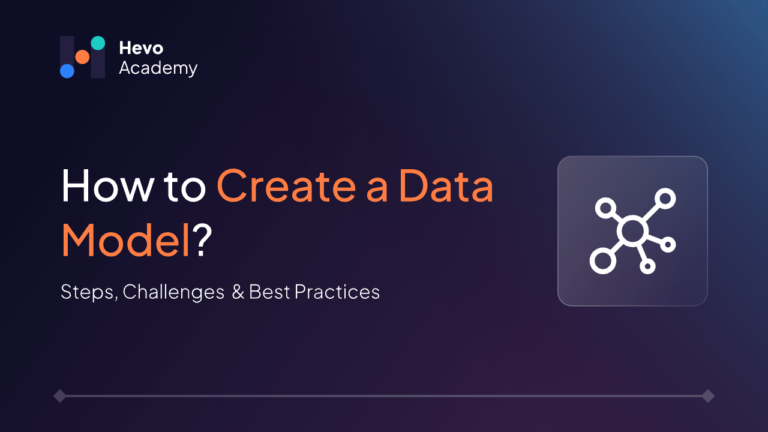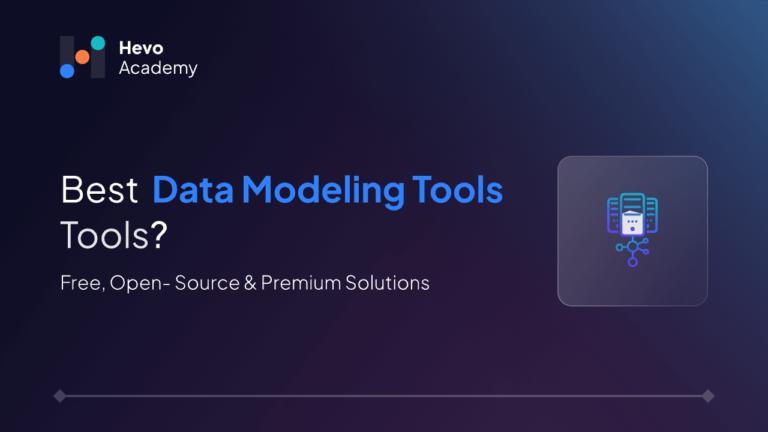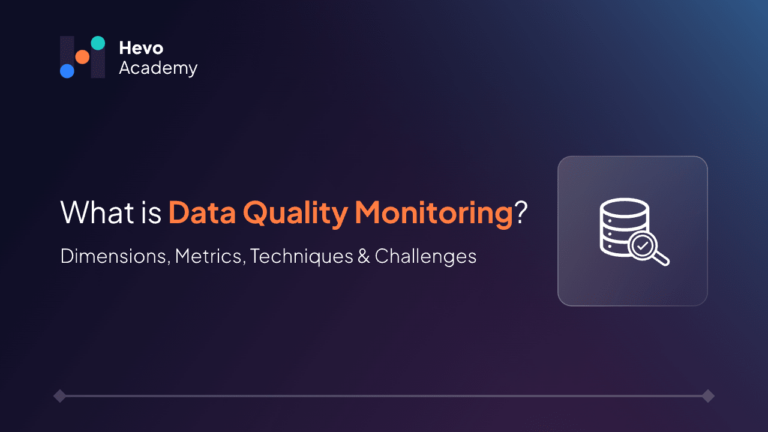Advancements in data storage and management technologies have transformed the world. Today, we use data to find cures for diseases, construct buildings, and even efficiently target ads on social media. Data is essential for data practitioners to identify patterns and gain insights. For example, customer data must include details like product purchases to be helpful for a product team. Similarly, data must consist of customer loan status information to be relevant for a financial underwriting team. Data modeling is critical to addressing these issues. A data model is the process of assigning rules to data. It is crucial to uncomplicate data and convert it into useful information that an organization can use to form strategies and make decisions.
Table of Contents
In this post, we will examine the concept of data modeling, why it is essential to organizations, the data modeling techniques and challenges, and, finally, data modeling best practices.
What is Data Modeling?
Data modeling is the process of creating a visual representation of a whole information system or parts of it to communicate connections between the data points and structures. Data models are usually built around an organization’s business needs. The rules and requirements are defined upfront through feedback from the organization’s stakeholders so they can be integrated into the design of a new system or adapted in the iteration of an existing one. Data modeling employs standardized schemas and formal techniques. This provides a standard, consistent, and predictable way to define and manage data resources across an organization or beyond.
Levels of Data Modeling
- Conceptual Level: Used in the early stages of a project to understand the requirements, this gives a high-level view of what the system will contain and how the main components will be arranged.
- Logical Level: It takes it a step further, breaks down the data into smaller logical elements, and creates a visual schema of their relationships. It helps organizations plan for data consolidation and segmentation.
- Physical Level: Based on the logical model, this describes how the data will be structured in a specific database management system. A blueprint for data engineers to visualize and implement the database structure.
Read about What is a Data Model to get a better understanding of this.
Why is Data Modelling Important?
A data model is one of the most critical tools in data management. It allows organizations to document data requirements before analyzing data and creating predictive models. Developers can also use it to identify errors before writing their code.
Data modeling can be used to keep records of data blocks and their movement within a business organization’s systems, assisting data architects in creating conceptual frameworks. Today, data users use data models to develop business intelligence and predictive applications more efficiently.
That said, the objective of any data model is to
- Illustrate the data stored and used within a system
- Explain the what, where, why, and who of data elements
- Find and establish the relationship between the different data types
- Establish the methods data can be organized and grouped
- Identify the formats and attributes of the data
Data modeling techniques
1. Entity-Relationship (ER) Model
The ER model shows the relationships between entities in a database using standard diagrams. The ER model comprises three main components. They are entities, attributes, and relationships. The Entity represents a real-world entity, such as an individual or location, and is displayed on tables. The attributes explain the features of each entity. At the same time, a relationship is a connection between two or more entities that can take several formats, such as one-to-one, one-to-many, or many-to-many.
2. Relational Model
The Relational models are mainly used in database architectures to connect data in tables through rows and columns. The objective here is to simplify the data, offer a clear perspective, and facilitate efficient storage and analysis. Additionally, it follows the principles of set theory and predicate logic, and it forms the basis of relational databases.
4. Dimensional Model
Dimensional models are primarily used in data warehouse design with the goal of optimizing a database for quicker recovery of information. They also help clear redundancy and inconsistencies, thus contributing to better data quality.
5. Data Warehouse Model
Data warehouse modeling is the process of building and arranging data models within a data warehouse platform. In traditional architecture, there are three main types of data warehouse modeling: enterprise warehouses, data marts, and virtual warehouses.
You can also take a look at our detailed comparison of data lake vs data warehouse vs data lakehouse to understand their key differences and use cases.
6. Hierarchical Database Model
The hierarchical model arranges data as a tree while maintaining a parent-child relationship within records. A parent may have more than one child, while a child record is limited to having only one parent. In a hierarchical model, changes to a parent record are automatically transmitted to its children. This is very useful, especially when organizations want to maintain data consistency.
Additionally, you can gain complete control over data by limiting access to specific levels in the hierarchical model.
7. Network Database Model
This is an extended version of the hierarchical model. It allows a child to record as having one or more parents. When compared to the hierarchical approach, it permits for more flexible data access.
By integrating the network model strategy into the data modeling process, Organizations can take note of the complex relationships and interchanges between different data points, thereby improving the precision of the overall data model.
8. Big Data Model
Analyzing big data can be a bit challenging with traditional models due to the huge amount of data involved. To manage this process very well, organizations may take advantage of the big data modeling techniques. This approach is tailored to address the distinctive features of big data, which include the volume, velocity, variety, and variability. By using visual models, like diagrams, charts, and graphs, organizations quickly generate insights from huge and complex datasets.
9. Agile Data Modeling
This model combines all of the agile software development techniques, such as Agile Manifesto and Scrum. Organizations use this model to design database architectures that are adaptable and responsive to changes in business needs.
In general, by using this method, it is possible to refine the data model based on feedback from end-users and growing business needs. This dynamic strategy enables organizations to adjust the data model and incorporate new elements quickly.
10. Object-Oriented Data Models
We use this model when relational data models and object-oriented programming are combined. Here, an object represents data and relationships within a structure. Attributes also define an object’s behavior by establishing its methods and properties.
Such a model is helpful because the objects can have numerous relationships between them. The two main concepts of object-oriented data models are classes and inheritance, where classes refer to a collection of similar objects due to their common attributes and behaviors. In contrast, the inheritance concept allows new classes to inherit behaviors (attributes) from other courses. If you are into software development, you might know these concepts.
Challenges in Data Modeling
Although data modeling is an integral component for effective management and analysis of data, some of the challenges faced during modeling include.
- Business Requirements Understanding
Business data requirements are constantly changing, so data models need to be designed to accommodate these changes over time. Additionally, translating the organization’s business needs into technical requirements can be very challenging, especially when dealing with complex business processes.
- Data Quality and Consistency
Inconsistent Data Issue: If the data model is built on a wrong premise, the analysis and decisions based on it will most likely be wrong. Therefore, the quality and data consistency of the data model should be maintained.
Difficulties in Data Cleaning and Standardization: Data cleaning and standardization are often tricky and time-consuming when dealing with complex and extensive datasets.
- Data Complexity and Volume
Handling Big Data: As data storage requirements grow daily, it is imperative that data models be efficient and scalable to accommodate bulky datasets.
Complex Data Structures: These include hierarchical and graph-based data, and they can be challenging to navigate.
- Evolving Technologies and Data Sources
Adapting to New Technologies and Data Integration Challenges: Data models must be able to adapt to emerging technologies and new data sources, such as NoSQL databases, cloud data warehouses, and IoT devices. Also, Integrating data from multiple sources with different data formats and structures can sometimes be complex.
- Data Model Performance and Scalability
Designing efficient data models and techniques for query optimization is crucial for ensuring optimal performance. Data models must also be scalable to handle the increasing data volumes and user demands.
- Security and Privacy Issues
Dealing with sensitive data always brings up issues of security, such as the use of encryption and the application of various access mechanisms.
Best Practices for Data Modeling
- Data Model as a Blueprint and Specification: Data models should be a helpful guide for data practitioners who design database schema and create, update, manage, control, and analyze data.
- Collect business and data requirements: Collect input from Organization stakeholders, business analysts, and other subject matter experts to design conceptual and logical data models based on business needs. Also, data models must be flexible enough to accommodate the evolving business needs and technology.
- Develop models iteratively and incrementally. The best approach for organizations is to arrange models into the subject areas identified in the conceptual model design and develop those subject areas one after the other. Afterward, the interconnections between the data models will be addressed.
- Use a data modeling tool to design and support the data models: Data modeling tools can create visual models, documentation, data dictionary, and data definition language code required to create a physical data model.
- Permissions and Governance: Data practitioners should be aware of the organizations’ varying rights and data governance requirements. Working collaboratively with your security team to verify that your data warehouse adheres to all applicable regulations would be beneficial.
- Indicate the level of Grain: It is a good practice to always indicate the granularity level at which the data will be kept. Usually, the least proposed grain would be the starting point for data modeling. Then, you may decide to modify and combine the data to obtain summary insights.
Conclusion
Good data modeling and database design are essential to developing functional, reliable, and secure application systems and databases that work well with data warehouses and analytical tools. Organizations can enhance data-driven decision-making, streamline operations, and maximize data utility by applying appropriate data modeling techniques, addressing challenges, and implementing best practices.
Looking to simplify your data integration for effective modeling? Hevo’s no-code platform lets you seamlessly connect and load data from various sources into your data warehouse, setting a strong foundation for data modeling. Sign up for 14-day free trial and experience how easy it can be to streamline your data pipeline, ensuring accurate and reliable data for all your modeling needs. Get started today!
Frequently Asked Questions
1. What are the data modeling techniques?
Entity-Relationship, Dimensional, Object-Oriented, and Hierarchical, among others.
2. What is the best practice of data modeling?
Define clear objectives, ensure data quality, and update models regularly.
3. What are the 4 approaches to data modeling?
Conceptual, Logical, Physical, and Dimensional modeling.






